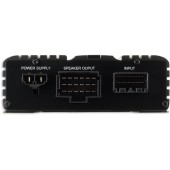Amplifier Alpine PDP-E802DSP
8-channel digital amplifier with DSP
More about the product
More about the product
We will help you with your purchase
- Use our consulting room
- You can return the goods to us within 14 days
- Try the product at our store
Amplifier Alpine PDP-E802DSP
The PDP-E802DSP is the second generation of Alpine's 8-channel digital DSP amplifier. This amazing all-in-one solution enables audio enhancement for virtually any vehicle thanks to its incredible versatility and connectivity options. It features 6 input channels (both preamplifier and speaker level) as well as up to 8 fully configurable output channels, allowing for a very wide range of system applications and flexibility. Fine-tune your sound with a professional 240-band parametric EQ, 8-channel digital time correction, as well as an 8-channel digital crossover.Use Alpine PC software to connect wirelessly or via USB to the PDP-E802DSP to set up the system. Very intuitive and easy to use software allows full control over all settings and displays all data in a very nice graphical user interface. The free Alpine Remote Control app for the PDP-E802DSP (available for both Android and iPhone) lets you control your DSP amplifier on the go and includes essential functions such as master volume, subwoofer level, source selection, preset recall and more. The PDP-E802DSP is the perfect solution especially for OEM upgrades where the factory radio cannot be replaced with an aftermarket solution to achieve better sound. The Alpine DSP amplifier simply plugs into an existing OEM system and allows you to build any sound system around your factory system.
This versatile DSP amplifier offers many improvements for easier installation and better sound quality. On the hardware side, a newly designed input circuit improves noise cancellation, while a newly designed Pre-Out allows you to connect an additional subwoofer amplifier if needed. The signal-to-noise ratio has been improved and color-coded jumpers with clear labels have been included to make installation and setup easier for the installer. There are many other improvements, such as better Wi-Fi stability, more detailed settings for RUX-KNOB2 behavior, as well as automatic adjustment of the supply voltage depending on load and volume. A new automatic impedance test protects your equipment from incorrect connections.
- 6CH analog input for highly flexible system integration
- Total power 700 W RMS into 4 Ω
- 100 W per channel into 4 Ω
- 120 W per channel into 2 Ω
- 200 W into 2 Ω (two parallel channels)
- RCA (low level) (10 kΩ): 0.5 to 4 V (rms)
- Speaker line (high level) (22 Ω): 2 to 18 V (rms)
- 1 TOSLINK/SPDIF digital input
- Up to 8 high power speaker outputs
- 110 dB signal-to-noise ratio (digital input)
- Channel separation > 75 dB
- USB Device input for DSP settings using a PC
- Wireless connection with separate module (amplifier setup for PC only) or wireless audio streaming (smartphone or PC))
- Class D amplifier with fully digital audio path
- ADC by Burr Brown
- Remote app for iOS and Android with basic control functions (main level, sub level, preset recall, source selection)
- Preamp output (copy from channel 8, for external subwoofer amplifier)
| Catalog number | PDP-E802DSP |
| Brand | Alpine |
| Links | Official web presentation |
| Number of amplifier channelsAmplifiers are divided into: - Monoblocks - 2-channel - 3-channel - 4-channel - 5-channel - 6-channel - multi-channel Each channel is used to power one speaker for the coaxial type, or one side if they are component speakers. Monoblock type amplifiers are mainly used for subwoofers. 2-channel are suitable for both subwoofers and, for example, the front pair of speakers in a car. 3-channel is used for front or rear speakers + subwoofer. 4-channel are used for front + rear speakers or 1 pair of speakers + subwoofer. 6 or 5-channel are used for 2 pairs of speakers + subwoofer, most often. Bridging means connecting the amplifier to a bridge, using the + pole from one channel and the - pole from the other channel. In most cases this is shown as "BRIDGED" on the amplifier. | 8 |
| Energy class of the amplifierAmplifiers are divided into two basic classes: analog and digital . Analog amplifiers (A/B) have higher consumption requirements, but usually have a more natural sound. Digital amplifiers (D) have significantly lower consumption and higher efficiency, but the sound may not be as faithful as with classic analog amplifiers. | D |
| Signal-to-noise ratioThe signal-to-noise ratio means that the output signal always contains noise. The signal-to-noise ratio expresses how much of this noise is compared to the useful signal. The so-called A value is given, which does not take deep and very high frequencies into account. This corresponds to the characteristic of human hearing, which is not so sensitive to deep frequencies, especially below 1 kHz. The higher the value, the better the amplifier is. | > 75 dB |
Product comments
Evaluation
ask us


























